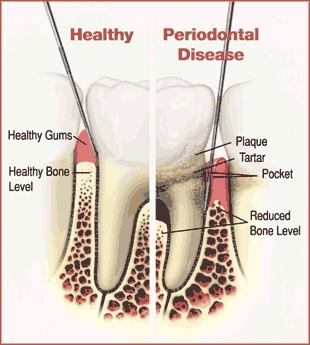Diseases
of the gum and surrounding bone tissue
|
Periodontal (gum) diseases,
including gingivitis and periodontitis, are
serious infections that, left untreated, can lead
to tooth loss. The word periodontal
literally means "around the tooth."
Periodontal disease is a chronic bacterial
infection that affects the gums and bone
supporting the teeth.
Periodontal
disease can affect one tooth or many teeth. It
begins when the bacteria in plaque (the sticky,
colorless film that constantly forms on your
teeth) causes the gums to become inflamed.
In
the mildest form of the disease, gingivitis, the
gums redden, swell and bleed easily. There is
usually little or no discomfort. Gingivitis is
often caused by inadequate oral hygiene.
Gingivitis is reversible with professional
treatment and good oral home care.

Untreated
gingivitis can advance to periodontitis. With
time, plaque can spread and grow below the gum
line. Toxins produced by the bacteria in plaque
irritate the gums. The toxins stimulate a chronic
inflammatory response in which the body in
essence turns on itself, and the tissues and bone
that support the teeth are broken down and
destroyed. Gums separate from the teeth, forming
pockets (spaces between the teeth and gums) that
become infected. As the disease progresses, the
pockets deepen and more gum tissue and bone are
destroyed. Often, this destructive process has
very mild symptoms. Eventually, teeth can become
loose and may have to be removed. Periodontitis
is also associated with osteoporosis. In such cases the
osteoporotic bone can allow the periodontal
infection to spread deeper in the body of the
jaws, opening the door for chronic bone
infections such as chronic non-suppurative
osteomyelitis.
The main cause of periodontal
disease is bacterial plaque, a sticky, colorless
film that constantly forms on your teeth.
However, factors like the following also affect
the health of your gums.
|

